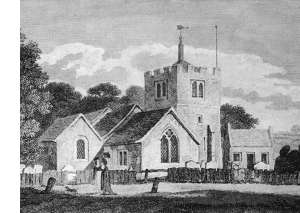
This drawing of Grays Parish Church was made in 1807. Before the major
extension and reconstruction in the 1860s, the Church was much smaller
than it is today. The Chancel was half the length it is now. The Nave
included what is now the choir and ended just past the old south door.
The people also sat in the ground floor of the Tower and in the south
Chapel which was sometimes called the south aisle.
In this drawing the Chapel
is the building to the left with the round arched window. The shape
of this window and other features still visible in the present building
such as the old north and south doorways has led to the conclusion
that the Church was built in the early Norman period. The Chapel could
therefore be over 800 years old and was used as a chapel up until
1935 when the old pipe organ was moved there from the base of the
tower.
In 1154 William de Ferrers, the Lord of the Manor at the time, gave
the Church to the Knights Hospitallers of St John, as his charter
says, “for the safety of my soul and those of my wife and heirs
and predecessors”. This suggests that the Chapel was provided
as a Chantry Chapel where prayers would be said for the de Ferrers
family.
During the Medieval Period the responsibility for the Chapel became
separated from the main rights and responsibilities for the Church
For instance, the church records tell us in 1810 “Mrs. Theobald
(then Lady of the Manor) repairs the south aisle (i.e. the Chapel)
Zachary Button, who holds the presentation, repairs the Chancel, and
the Parish repairs the large aisle (i.e. the Nave) steeple and vestry.
The Lord of the Manor from 1654 until his death in 1710 was William
Palmer. In 1706 he drew up a Trust Deed founding the Palmer’s
Charity which built the first and successive Palmer’s Schools
and supports the Palmer’s College of today.
William Palmer, as Lord of the Manor listed ownership of the Chapel
in the marriage settlement when he married his first wife Anne in
1657. In his will, made 10 days before he died in May 1710, he expressed
the wish to be buried in “his Chancel at Grays”. This
reference to Chancel must be an error by those drafting the will.
Those who held the rights and responsibilities for the Church claimed
the right of burial in the Chancel. Members of the Button family,
who owned the rights from 1777 to 1829, are buried there.
Two historians visited the Church soon after William Palmer’s
death. Holman, who himself died in 1720, wrote “William Palmer
Esq. was buried in the south aisle of the Church, May 1710”.
Salmon in History of Essex (1740) writes “in the south transept
of the Church, William Palmer was buried.
H.W. King visited the Church in August 1871 (after the major reconstruction
and additions in the 1860s) and could not find the inscription to
William Palmer. But King clearly states that in his opinion “the
south transept was undoubtedly a chapel or chantry with an altar and
in the wall is a piscina. This is sufficient to account for an aumbry
in this chapel and especially if a chantry priest was attached to
it.” This piscina (bowl for water) and aumbry (locker) are still
there built into the walls.
We can be as certain as we can be without seeing the grave-stone,
that William Palmer is buried in the proposed Palmer Chapel.


